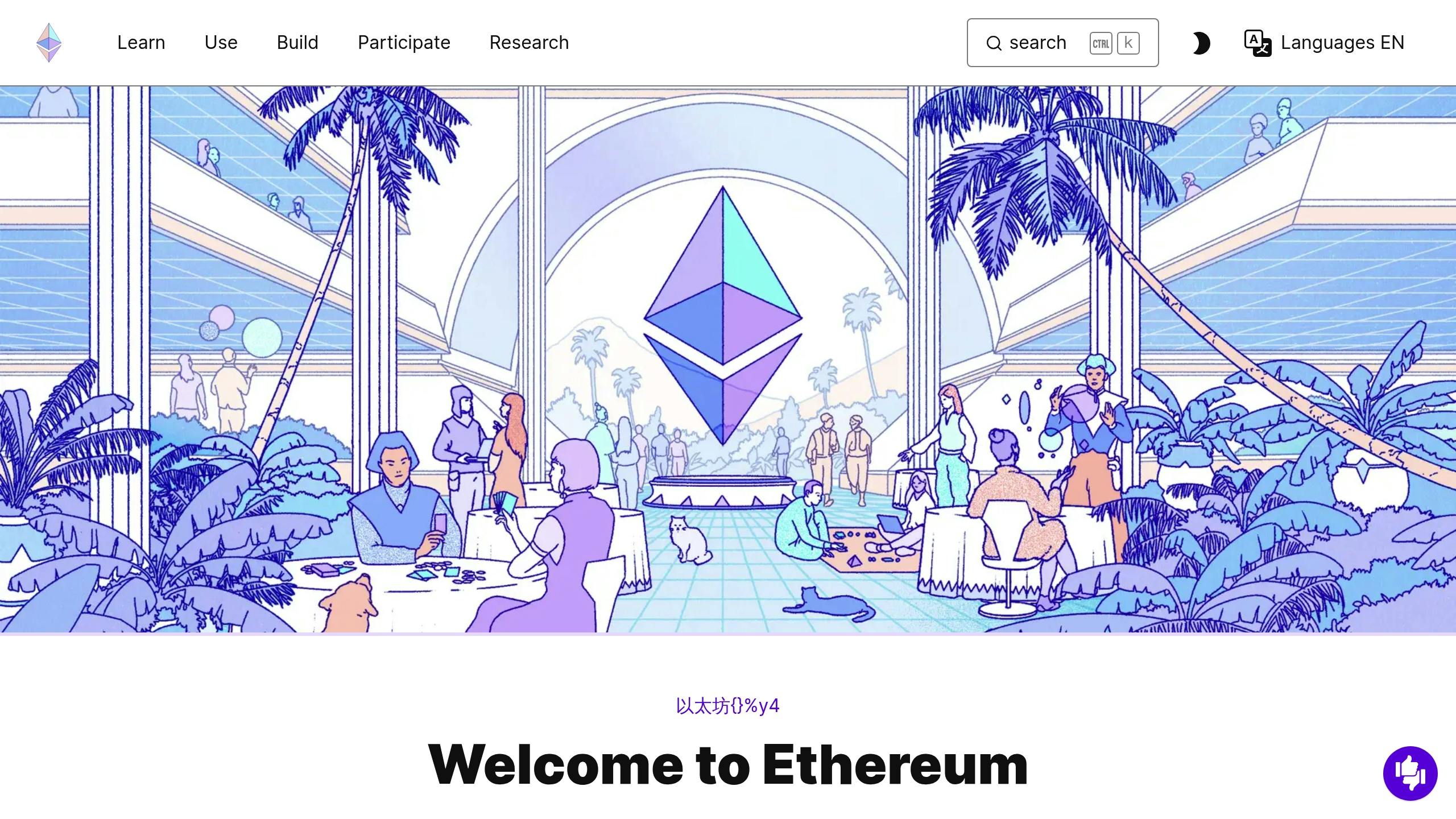ETH 2.0 is the upgrade that transforms Ethereum into a faster, more energy-efficient, and scalable blockchain. It replaces Proof of Work (PoW) with Proof of Stake (PoS), cutting energy use by 99.95% and paving the way for up to 100,000 transactions per second (TPS). Key improvements include reduced gas fees, staking rewards, and sharding for better scalability.
Key Highlights:
- Energy Efficiency: PoS reduces energy consumption by 99.95%.
- Scalability: From 15 TPS to a target of 100,000 TPS with sharding.
- Lower Costs: Gas fees drop due to increased transaction capacity.
- Staking Rewards: Validators earn ~3.1% APR by staking 32 ETH.
- Enhanced Security: PoS and slashing penalties deter malicious actions.
ETH 2.0 sets the stage for Ethereum’s future with improved speed, cost-efficiency, and decentralized finance (DeFi) capabilities. Upcoming updates like EIP-4844 and Pectra aim to further boost scalability and simplify staking.
Ethereum 2.0 Upgrades Explained

Proof of Stake Explained
Ethereum’s transition to Proof of Stake (PoS) under ETH 2.0 introduces a new approach to transaction validation and network security. This shift prioritizes efficiency and reduces energy consumption, fundamentally altering how the network functions.
How Proof of Stake Works
Unlike the energy-heavy Proof of Work system, PoS depends on validators who stake their ETH to secure the network. To participate, validators must stake 32 ETH. The system randomly selects validators to propose new blocks, while others verify and confirm them.
| Aspect | Proof of Work | Proof of Stake |
|---|---|---|
| Resource Required | Computing power & electricity | 32 ETH stake |
| Energy Usage | ~78 TWh/year | 99.98% lower |
| Security Model | Electricity cost | Staked ETH |
| Node Operation | Mining hardware | Standard computer |
| Barrier to Entry | High hardware costs | 32 ETH minimum stake |
ETH 2.0 Staking Guide
Ethereum’s network now has over 1,052,754 validators and more than 33.6 million ETH staked. Validators earn an Annual Percentage Rate (APR) of 3.1%, offering steady rewards for their role in maintaining the network.
To become a validator, participants must meet certain requirements:
-
Hardware Needs
Running a validator node requires a dedicated computer with reliable internet. Unlike mining, the hardware requirements are modest, making it easier for individuals to stake from home. -
Staking Options
Users can opt for solo staking, which requires 32 ETH, or join staking pools that allow participation with smaller amounts. -
Validator Duties
Validators are responsible for keeping their nodes online and following network protocols. As stated by the Ethereum Foundation:"Staking is the act of depositing 32 ETH to activate software. As a validator you’ll be responsible for storing data, processing transactions, and adding new to the blockchain. This will keep Ethereum secure for everyone and earn you new ETH in the process."
These measures ensure that validators contribute to the network’s security and functionality.
PoS Network Changes
The transition to PoS, finalized during The Merge, brought major improvements to Ethereum’s energy efficiency and security. The network’s energy consumption has dropped significantly.
To further secure the network, Ethereum enforces strict penalties for malicious actions, including:
- Loss of staked ETH (slashing)
- Removal from the validator set
- Forfeiture of staking rewards
The more ETH staked, the harder it becomes for attackers to compromise the network, as they would need to risk substantial capital. These mechanisms enhance Ethereum’s security and support decentralized trading and smoother DEX operations.
Speed and Scale Updates
ETH 2.0 is changing the game for Ethereum by making transactions faster and more cost-effective. Its new approach tackles scalability challenges head-on, delivering a more efficient blockchain experience.
Sharding Basics
Sharding introduces a new way for Ethereum to handle transactions. Instead of requiring every node to validate all transactions, the network is divided into 1,024 smaller groups called shards. Each shard processes its own transactions independently but stays securely connected to the rest of the network. Think of it as adding more lanes to a highway, allowing traffic to flow more smoothly.
| Aspect | Traditional Ethereum | Sharded Ethereum |
|---|---|---|
| Transaction Processing | All nodes handle everything | Split across shards |
| Node Requirements | Full blockchain history | Partial history per shard |
| Network Load | Centralized | Spread across the network |
| Scalability | Limited by single chain | Grows with shard count |
This system drastically increases the network’s speed and capacity.
Speed Comparison
Under ETH 1.0, Ethereum could process fewer than 25 transactions per second. ETH 2.0 aims to handle up to 100,000 TPS, thanks to sharding, which boosts throughput more than a thousand times. For comparison, payment giants like Visa and Mastercard process around 24,000 TPS.
| Metric | ETH 1.0 | ETH 2.0 |
|---|---|---|
| Transactions per Second | <25 | Up to 100,000 |
| Network Throughput | Basic level | Over 1,000X improvement |
| Validation Method | Sequential | Parallel |
Lower Gas Fees
With more transactions being processed, gas fees are expected to drop, benefiting users and decentralized exchange (DEX) platforms. The updated fee structure includes a burned base fee (introduced by EIP-1559), optional priority tips for quicker processing, and dynamic adjustments based on demand.
These updates make Ethereum not only faster but also more affordable, especially for applications requiring frequent and low-cost transactions.
sbb-itb-dd9e24a
Changes for DeFi and DEX
ETH 2.0 is reshaping how decentralized finance (DeFi) applications and exchanges work, offering new possibilities for developers and users alike.
Faster dApp Performance
With ETH 2.0, transaction speeds skyrocket, jumping from 15 transactions per second (TPS) to as many as 100,000 TPS. This speed boost means decentralized applications (dApps) can handle transactions almost instantly, allowing real-time trade execution on decentralized exchanges (DEXs). It’s a game-changer for how DeFi apps connect with the Ethereum network.
DEX Trading Updates
ETH 2.0’s improved scalability reduces gas fees, cutting transaction costs significantly. This makes features like efficient order matching and cross-margin trading on platforms like Defx more accessible. The network’s increased capacity also supports larger trading volumes while keeping performance steady, helping DEXs compete with traditional exchanges.
New DeFi Features
The scalability enhancements open the door to advanced DeFi functionalities, especially in cross-shard services. These updates allow smooth integration between various DeFi protocols. With reduced latency and higher throughput, the network can handle complex financial operations more effectively.
"Beyond base scalability improvements, sharding is how Ethereum 2.0 is going to scale to meet demand."
What’s Next for ETH 2.0
Update Schedule
Ethereum is gearing up for the Pectra upgrade, scheduled for March 2025. This update packages eight Ethereum Improvement Proposals (EIPs) into a single release. Before the mainnet launch, testing will take place on Sepolia and Holesky throughout February 2025. One key change is EIP-7251, which increases stake limits from 32 ETH to 2,048 ETH, simplifying validator operations. This upgrade builds on earlier advancements in Proof-of-Stake (PoS) and sharding to improve overall network efficiency.
Current Issues
Despite progress, Ethereum still faces challenges that need addressing. The network’s current throughput is limited to 14 transactions per second (TPS), far below its long-term goals. While the move to PoS has cut energy use by 99.95%, scalability remains a pressing issue.
| Challenge | Current Status | Target |
|---|---|---|
| Transaction Speed | 14 TPS | 100,000 TPS |
| Validator Onboarding | Several days | 45 minutes |
| Staking Returns | 2.7% APR | Higher returns through compounding |
Another concern is the potential impact of staking withdrawals on network security and ETH price stability. To address this, EIP-7002 introduces execution layer-triggered withdrawals, giving stakers more flexibility with their assets. Future upgrades will aim to improve scalability and streamline validator processes.
Future Plans
Ethereum’s roadmap includes several updates to tackle its current limitations:
-
Enhanced Staking Mechanics
A new validator type (0x02) will enable more flexible staking options, including better withdrawal features and higher stake limits. This allows validators to manage larger portfolios efficiently, with the added benefit of compounding rewards. -
Scalability Improvements
EIP-4844 will introduce ‘blobs,’ a feature designed to reduce data storage costs for rollups. This is a critical step toward achieving the ambitious goal of 100,000 TPS. -
Network Optimization
EIP-7514 will adjust validator growth rates, moving from exponential to linear increases. This change ensures the network can scale without compromising stability.
Conclusion
Main Points
The switch to Proof of Stake has cut energy use by an impressive 99.95%, while still protecting the network and opening up staking opportunities. By May 2020, DeFi apps made up 60% of the total value in Ethereum DApps, with more than $600 million locked in various protocols. Removing gas fees and speeding up transactions has made DeFi easier to use and more efficient.
| Aspect | Before ETH 2.0 | After ETH 2.0 |
|---|---|---|
| Energy Usage | Base Level | 99.95% Reduction |
| Transaction Speed | ~14 TPS | Up to 100,000 TPS |
| Consensus Mechanism | Proof of Work | Proof of Stake |
These improvements set the stage for the next wave of updates and opportunities for stakeholders.
Next Steps
With ETH 2.0’s benefits outlined, attention now turns to what’s next for Ethereum and its community.
Upcoming features like Proto-Danksharding (EIP-4844) are in the works to cut fees further and handle more transactions. These updates aim to build on the energy savings and scalability already achieved.
The Ethereum Foundation uses a vivid analogy to describe this transition:
"Imagine Ethereum is a spaceship that isn’t quite ready for an interstellar voyage. With the Beacon Chain, the community has built a new engine and a hardened hull. After significant testing, it’s almost time to hot-swap the new engine for the old mid-flight."
For developers and users, understanding these updates is key to taking full advantage of ETH 2.0’s features. Moving forward, Ethereum is focusing on improving user experience, boosting security, and preparing the network for future challenges. With rivals like Cardano and Polkadot already using Proof of Stake, Ethereum’s successful upgrade solidifies its place in the blockchain world.
